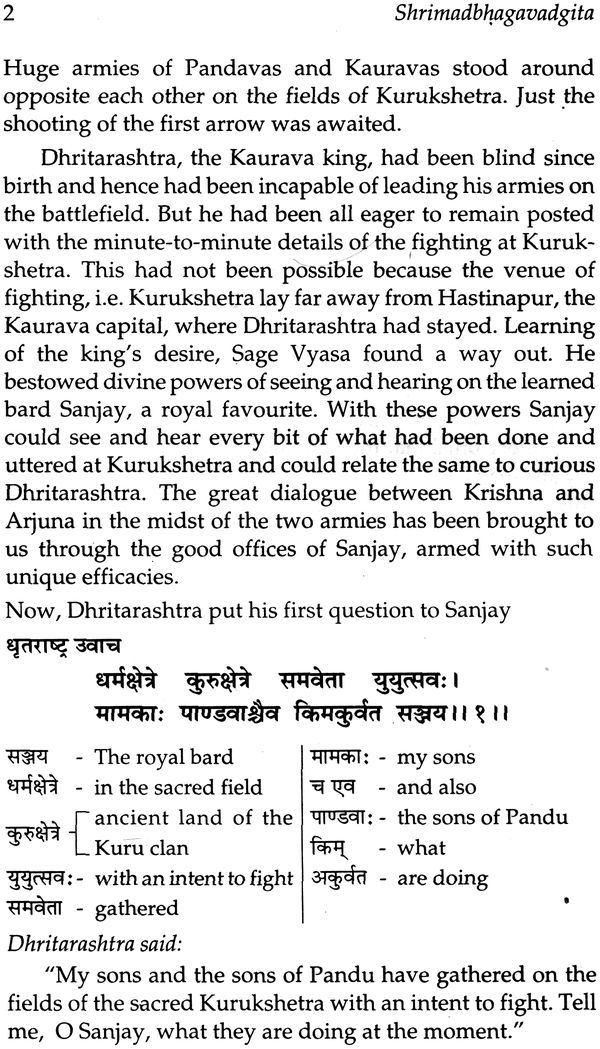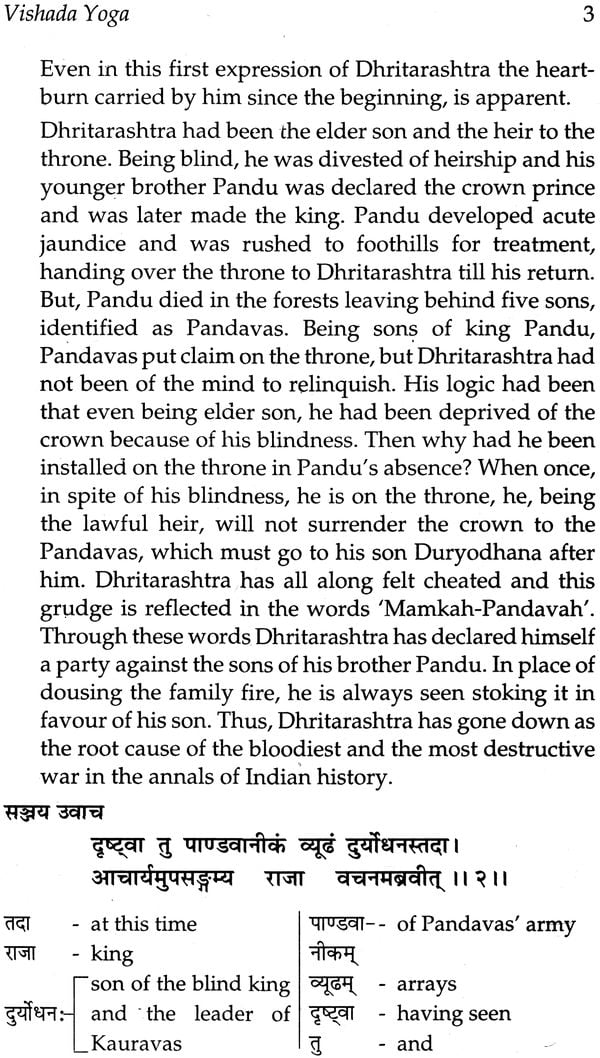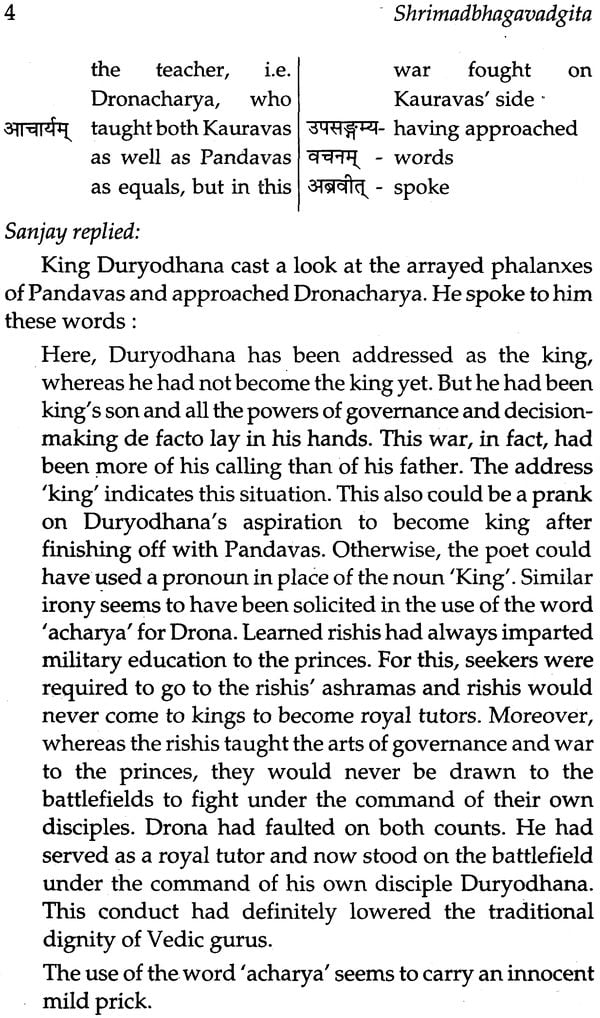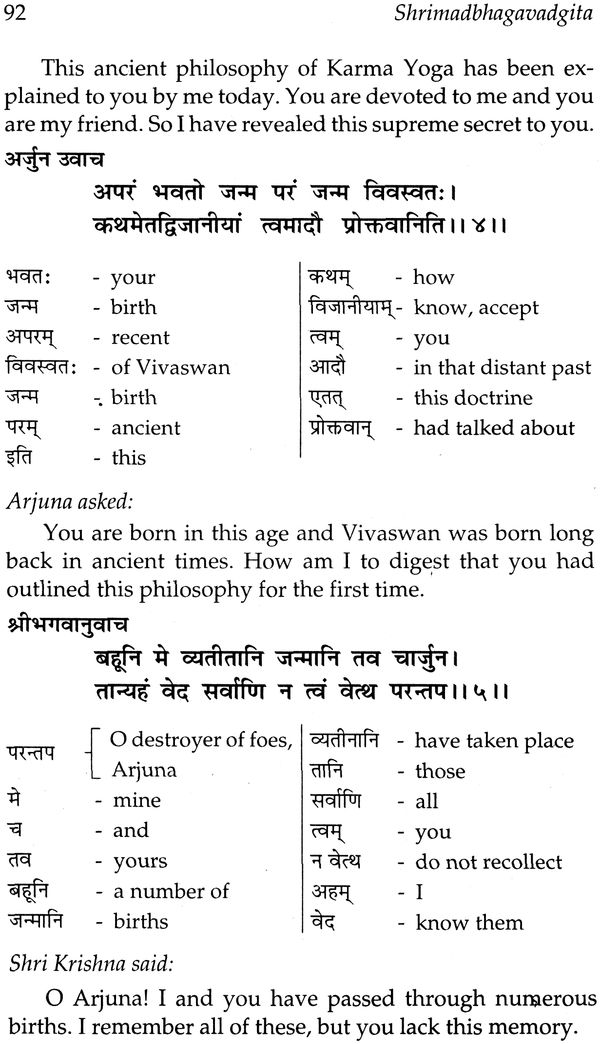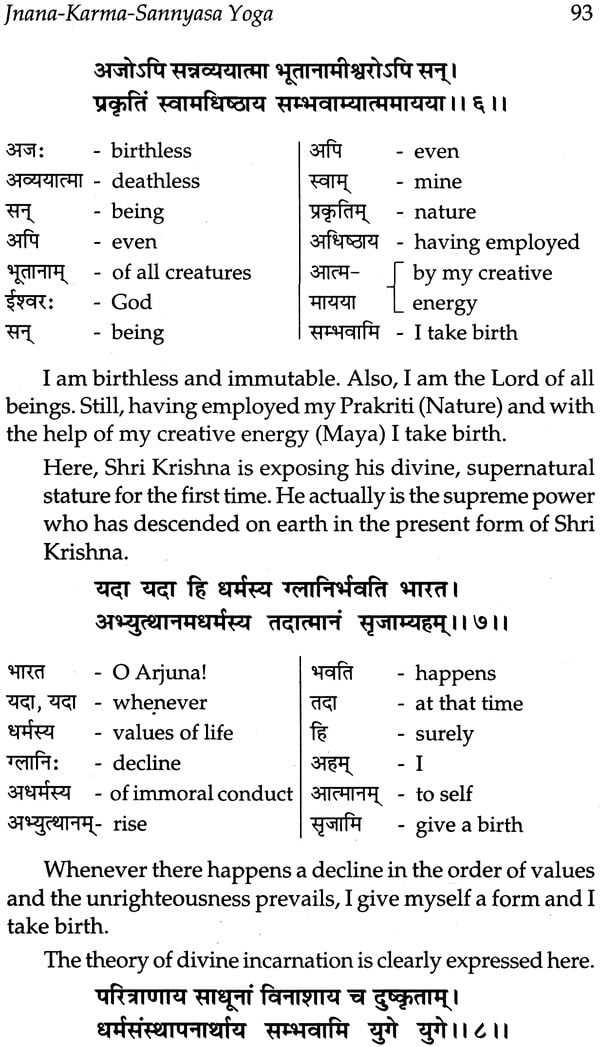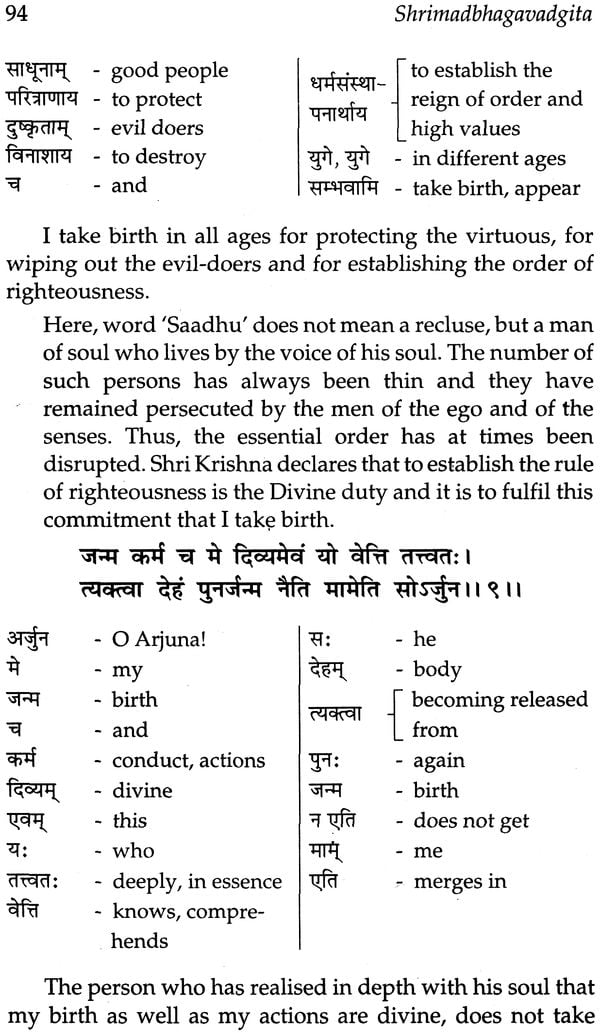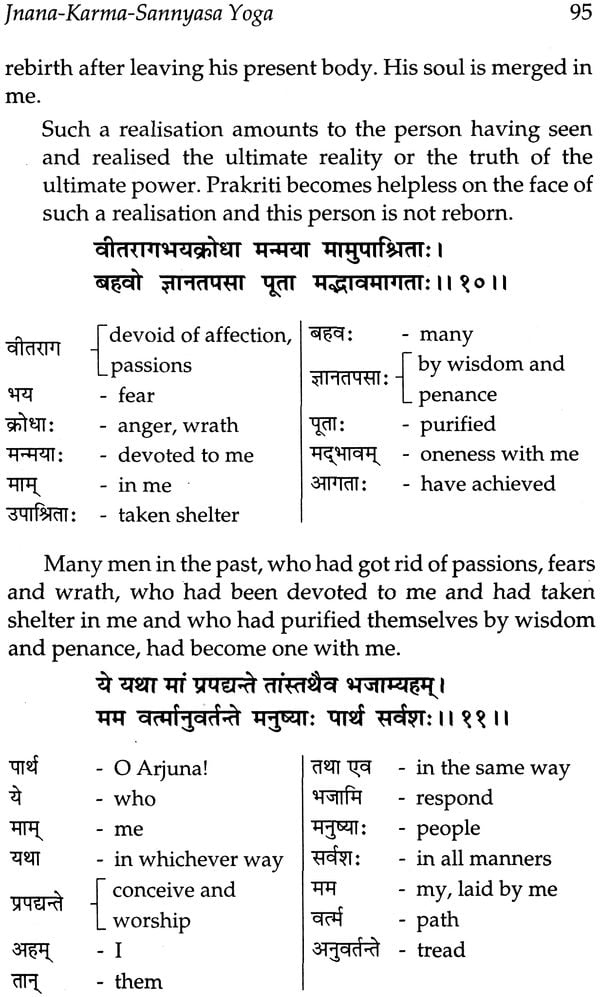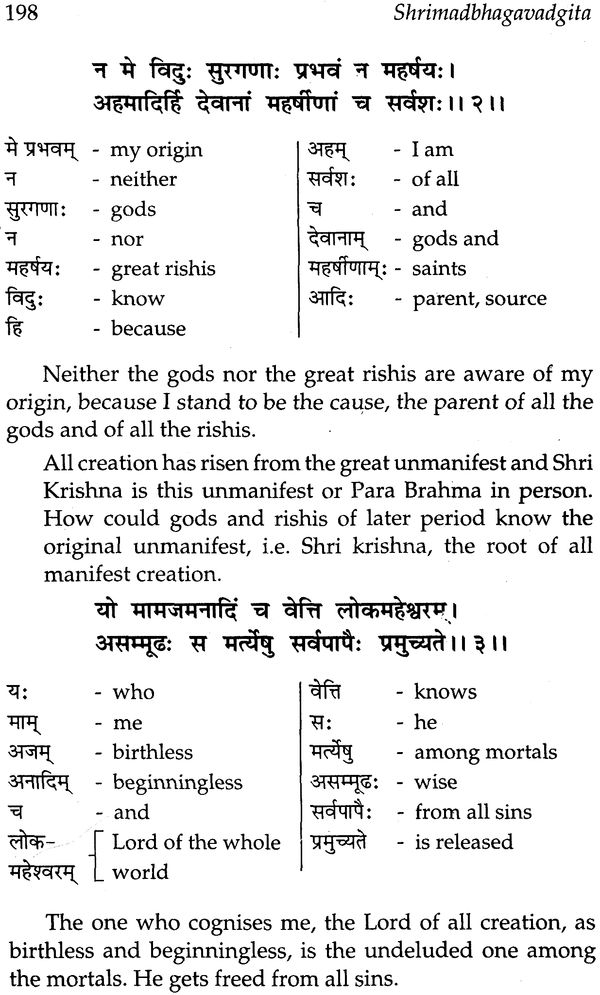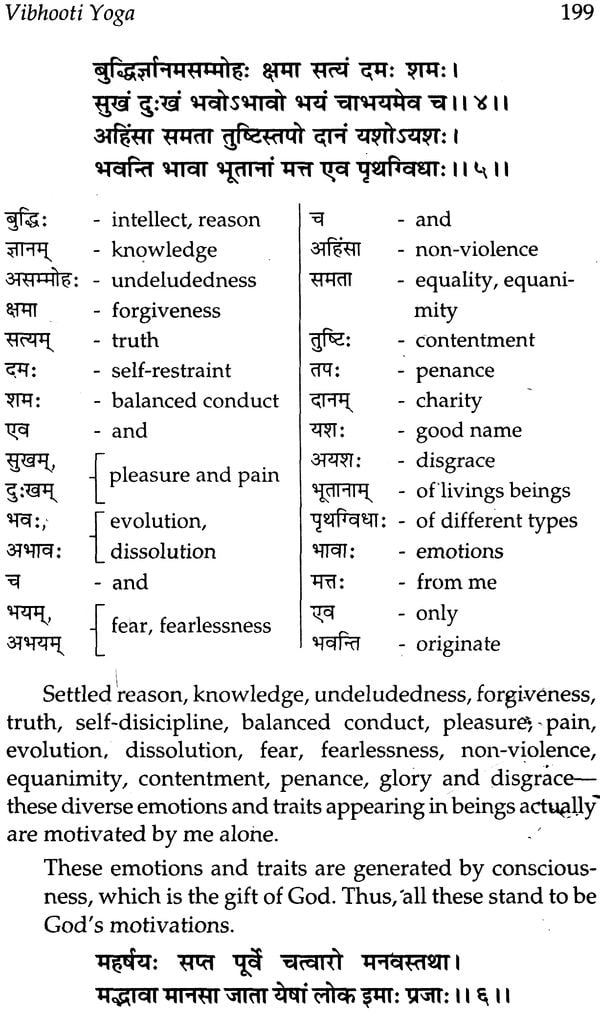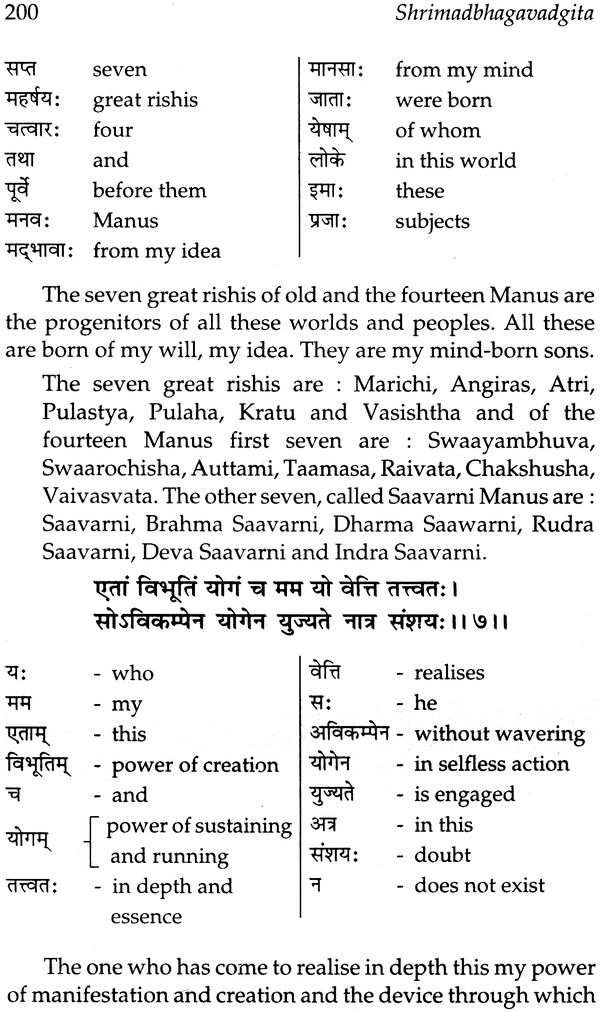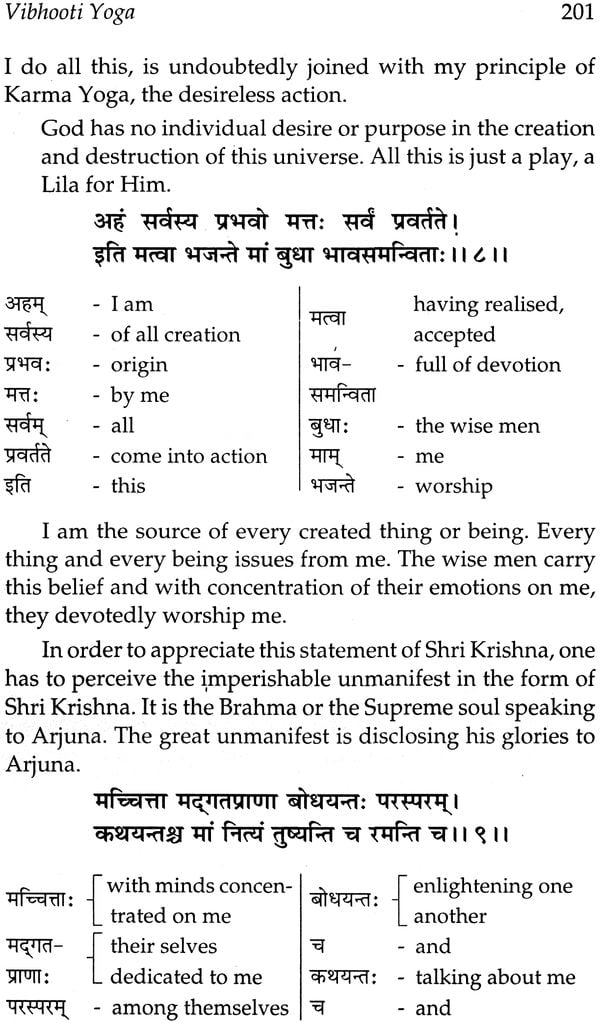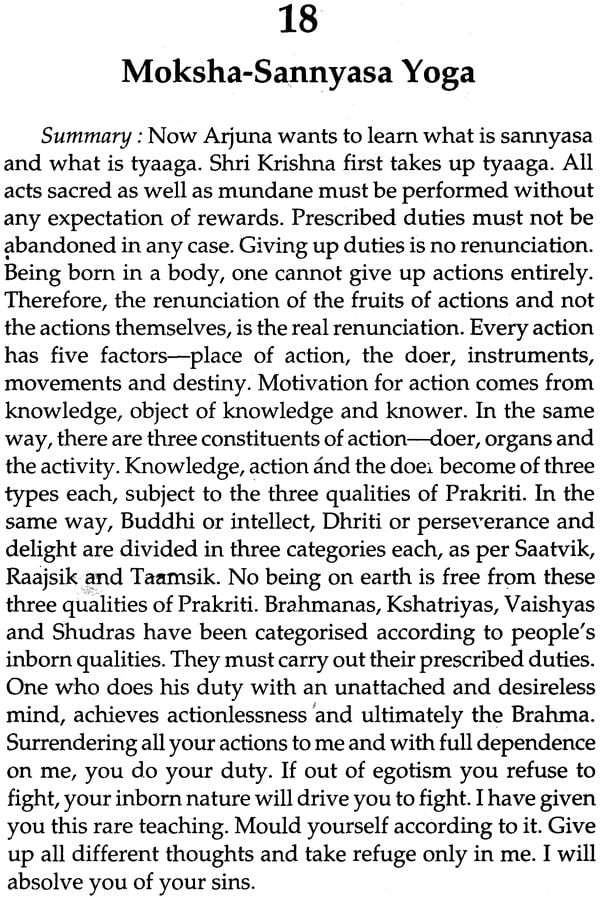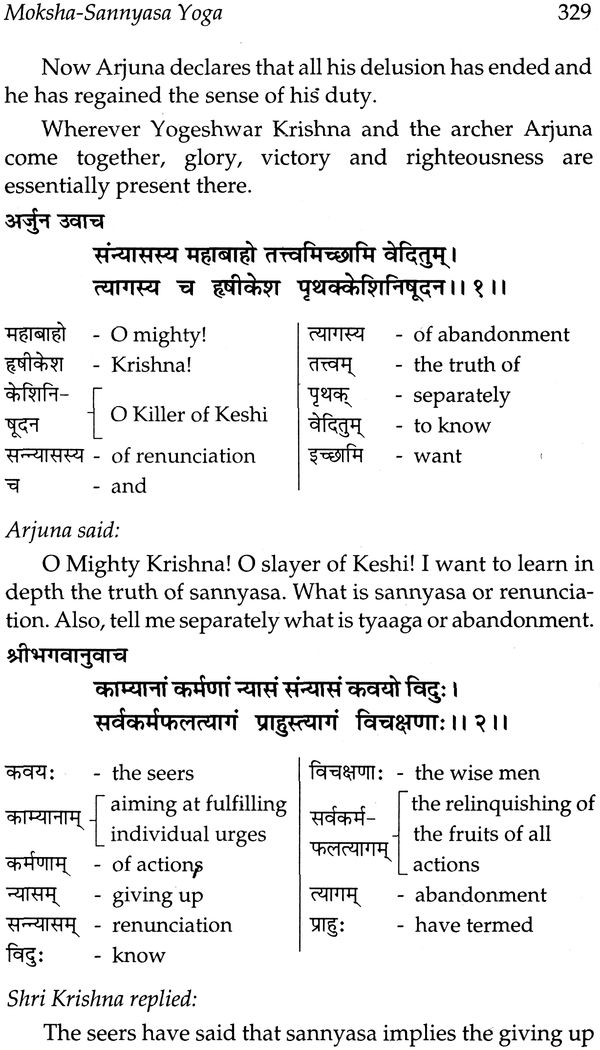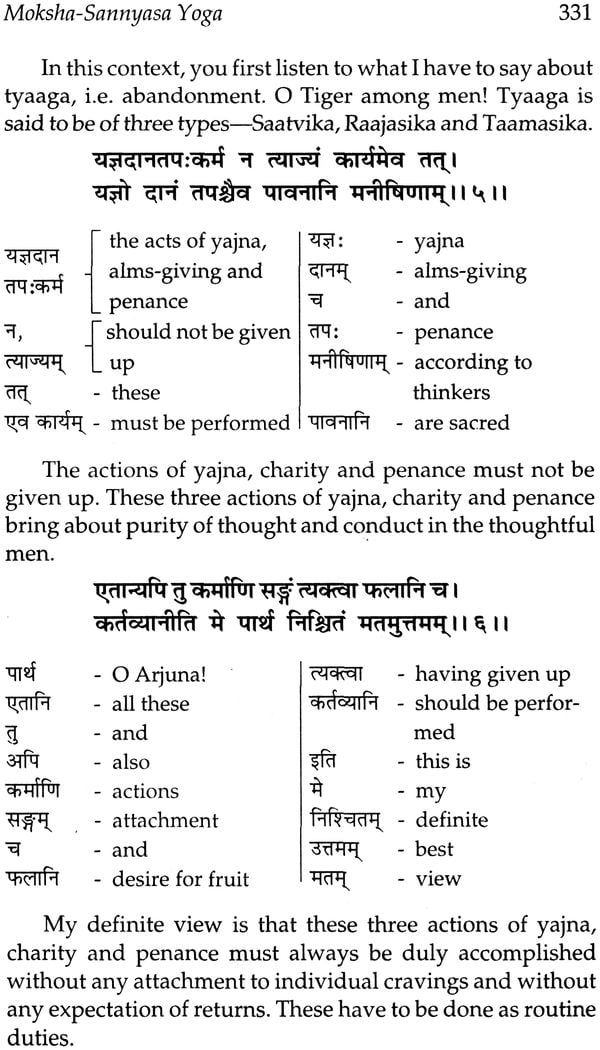
Shrimad Bhagavadgita: The Song Divine By Shri Krishna (Sanskrit Text Word-to-Word English Translation)
Book Specification
| Item Code: | NAJ332 |
| Author: | Virendra Kumar Gupta |
| Publisher: | Chaukhamba Sanskrit Pratishthan |
| Language: | Sanskrit Text with Word to Word Meaning English Translation |
| Edition: | 2013 |
| ISBN: | 9788170844871 |
| Pages: | 390 |
| Cover: | Hardcover |
| Other Details | 8.5 inch X 5.5 inch |
| Weight | 630 gm |
Book Description
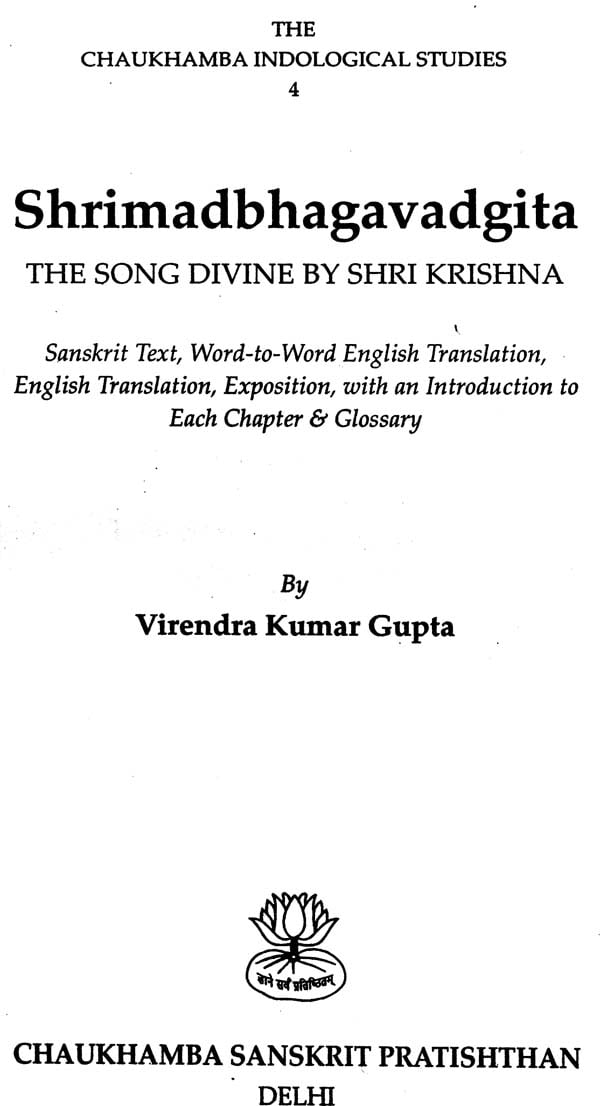
About the Book
Shrimadbhagavadgita is not the usual religious text in praise of the Almighty. It is the Ganges of wisdom with two essential banks, the one being the spiritual and the other worldly. The message of Shrimadbhagavadgita relies on two fundamental concepts, the Sthitapragya or the stability of intellect and Karmayoga or the desireless action, i.e. the action for the good of all and not for the satiation of one’s sensual and egoistic craves. Once the intellect becomes stable, the desireless action spontaneously flows from it, self-employing the person in the service of humanity. Shrimadbhagavadgita does not negate any of the two aspects of human existence, the spiritual and the worldly and seeks to put them in due perspectives.
About the Author
Born on 29th August 1928 in Saharanpur, Uttar Pradesh, Virendra Kumar Gupta started writing poems in Hindi in school days. His first book is a drama published in 1952. Later he wrote ten novels, three of these historical. He has written two novels for children and has also written two kavyas i.e. novels in poetry. He has also written two books in English entitled “The Inner Self” and “Ahimsa in India’s Destiny”. He interviewed eminent Gandhian author and thinker Shri Jainendra Kumar on Gandhian philosophy in practice putting 450 questions to him and thus co-authoring “Samay Aur Hum”, a book of 662 pages in question-answer form.
Preface
It would be improper to know and treat Shrimadbhagavadgita as a religious book. It is a great treatise on human phenomenon and on man’s duty in this world. Human psychology, spiritualism, ethics and political science are all integrated in this divine discourse. The concept of Para-Brahma or Supreme Soul and the soul have been depicted in it in such an elaborate picturesqeness that one gets awe-struck. All this elevates Shrimadbhagavadgita to the stature of a guide for all humanity and not just for Hindus, a section of it. Any man living in any part of the world and subscribing to any faith can look to Shrimadbhagavadgita for guiding him to the right path in life.
Shrimadbhagavadgita happens to be a perfect guide for achieving spiritual enlightenment as well as for attaining worldly wisdom. In common thinking these two are considered antithetical, but the Bhagavadgita declares these to be complementary, such that one can be reached through the other. Spiritual enlightenment and worldly wisdom are two essential ends of the same straight line of life or the two banks of the same river and none of the two can be written off. Men must walk on two legs and work with two hands. He stands handicapped if anyone of the two gets disabled. Bhagavadgita goes against the Buddhist concept that for any spiritual growth worldly life has to be relinquished as the initial step. According to Bhagavadgita the two must work hand-in-hand for an enlightened, delightful existence and a peaceful satiated termination of it.
Bhagavadgita, the divine discourse, was inspired by the perpetual question: In what way to react to a particular challenge in life? In what spirit should man meet it? This is no metaphysical puzzle. This is an innocent earthly question faced by every man at every step in his life. Every moment we stand confronted by a fresh problem, which cries for a fresh solution. Arjuna stands on the battlefield of Kurukshetra poised to fight Kauravas, his own kith and kin. A question arises within him. Should he shed the blood of his own brethren for a kingdom, however vile their conduct had been till the moment. He declares to Krishna that he would not fight, whatever be the consequences. Shri Krishna answers Arjuna’s question and in the process reveals a plan for making man’s individual and social life most creative, enriching and delightful. This plan runs in two parts. The first is Sthitaprajna and the other is Karma Yoga. In easy words we can say, knowledge and action. Knowledge motivates action and action enriches knowledge. Both are essential features of human life. Man lives his life by knowledge and action and it is by these that he has been able to create cultures and civilizations.
Sankhya philosophy relies solely on knowledge and denies action, because action, according to it, binds soul to Prakriti or matter, i.e. to the cycle of birth-death-rebirth. It pleads that release from this cycle can be achieved only through non-action. Shri Krishna accepts knowledge to be essential, but argues that knowledge should be the base and the motivation for action. If action is stopped, even our ordinary lives would become impossible. Action can be performed in such a way that it would not bind and that way is Karma Yoga. If Karma Yoga is adhered to, one can go on fulfilling the demands of individual and social lives without any tear of getting bound. Action done in the spirit of Karma Yoga will even secure release from all other sins. Sankhya’s denial of action has promoted an individualistic trend as is reflected in the concepts of Nirvan and Kaivalya of Buddhism and Jainism. Shri Krishna gives equal weightto both the aspects of human life, individual as well as social, one enriching the other. Nirvan or Kaivalya is attained by an individual for his individual self only. But Karma Yoga is essentially a communal-social activity involving and serving individual as well as social concerns. Refusing to fight is Arjuna’s individual stand born of his individual feelings of attachment and grief. Shri Krishna seeks to change the course of these individual feelings to Dharrna, Yajna, to the universal concern, and to the action necessitated by it. The whole Bhagavadgita is an advocacy of universal concerns in precedence to individual desires and cravings, mundane or spiritual.
What is implied by knowledge here? To know about soul, about Prakriti i.e. matter about soul’s bondage by Prakriti and about soul’s release from this bondage is considered knowledge. According to Sankhya, numberless souls and Prakriti are the two eternal elements. Prakriti attracts soul and with their union a living being comes into being. For acquiring release from this bondage in Prakriti’s grip i.e. from the cycle of birth-death-rebirth non-action is the only way, because action binds. Shri Krishna recognizes this version of Sankhya to the extent of Prakriti’s role in soul’s bondage. He says that above Prakriti and the Purusha i.e. soul, there exists Supreme Soul or Param Atma, who has created Prakriti and from whom all the souls have issued. Shri Krishna does not contribute to the idea of non-action or inaction being accepted as the only recipe for soul’s release. Non-action is individualistic. Moreover, if it is adhered to, the cycle of life would stop. All natural forces remain continuously engaged in action. Then, why should man opt for non-action. The thought of release through non- action is a negative concept, which could only be injurious to the health of human life. In its stead Shri Krishna puts forward the concept of-Karma Yoga i.e. selfless action. His point is that only those actions are binding, which aim at the fulfillment of sensual desires and egoistic cravings. When sensual desires and egoistic cravings are shunned and the action is undertaken as a duty for universal good, it does not bind. Care not about the fruits of action, he says. Fruits are not in our hands. Moreover, caring for fruits carries us back in the grip of individual cravings, which are sure to darken and delimit our view of reality. Any action done in this individualistic frame of mind must definitely prove to be a perverted action, giving out negative results. Shri Krishna’s advice is that action is to be fixed with totally an unprejudiced mind, a mind freed from all internal and external constraints i.e. expectations and associations.
In Bhagavadgita Shri Krishna has envisaged the image of an ideal individual, which he wants Arjuna to become. Characteristics of such an individual are described and discussed in great detail by Him.
The first requisite quality of such an ideal man is that he is master of his senses. Shri Krishna again and again asks Arjuna to exercise full control over his senses. Mastery over the senses does not mean curbing of senses or starving them of their objects. It only means that man drives the senses and not that senses drive the man. Senses must go on doing their jobs, but man must not become a slave to the objects of senses and a tool in their hands. Senses are meant to fulfill life’s needs, but egoistic cravings should not be misunderstood as needs. A distinction between need, wish and craving has to be genuinely appreciated and translated into practice. The man, who can do it, is saved of the risk of being waylaid and misdirected by senses or by the ego.
The second requirement is that man is not stirred and disbalanced by pleasure and pain, success and failure or honour and dishonour. He has to be convinced of his view of reality and of the stand taken by him after cool consideration, remaining, no doubt, flexible and open to revision. Thirdly, man takes a friend and an enemy with an equal feeling and in the same spirit. This would happen, because Shri Krishna’s ideal man deals with every person on human level and does not allow individual prejudices to vitiate relationships, which must be run on merits. This ideal man sees the same soul in all beings. He knows that the same Supreme Soul lives in all creatures in the form of individual souls, His parts. He recognizes that this soul is not the doer and all the actions are done by the Prakriti and also that the soul is only a witness and an enjoyer of Prakriti’s exploits. He has also realized that the Supreme Soul is the creator and the ultimate destroyer of this world, as depicted in the eleventh chapter. He is all the three, the Brahma, the Vishnu, and the Shiva. According to Shri Krishna only that person, who is armed with the realization of these mystic, spiritual truths, can be capable of meeting the upcoming challenges of life, mundane or spiritual. Only such a person is eligible to take right decisions at the right moments. Spiritual realization is as much crucial for worldy activities as the world remains crucial for spiritual achievements. Only mundane or only spiritual calculations are bound to lead to incomplete, fractional fulfilment or even to disastrous results. It is why Shri Krishna has delivered to Arjuna such a long lecture on ethics and spiritualism just to answer his simple question, whether to fight or not to fight. A whole garnet of mundane and spiritual considerations is implied in Arjuna’s decision.
This ideal man of the Bhagavadgita is the Sthitprajna, who has realized the essential knowledge, which has to be the basis of all his actions and relationships.
Shri Krishna has given great stress on comprehending the Supreme Soul, the Creator and the Father and also the Destroyer of this universe and all living beings. Shri Krishna is the personification of the Supreme Soul. The glories and powers of Supreme Soul or Shri Krishna are described in detail by Shri Krishna himself in chapter 7th. He says: “Arjuna, know that all beings are born of these two Prakritis i.e. the Para and the Apara natures of mine. I am the source and the end of all this creation.”
The knowledge and the in-depth realization of this mysterious truth is essential for the ideal man, because without these right direction cannot be achieved and man cannot sustain himself on the right course of thought and action.
With this realization secured, Shri Krishna preaches Arjuna to adhere to Karma Yoga, the selfless performance of duty. The characteristics of a Karma Yogi laid down by Shri Krishna are in no way short of a recluse or a sannyasi. A Karma Yogi is required to have full control over his senses. Individual desires and cravings are to be totally shunned. He should see the same soul in all the beings. He should inculcate no fascination and no enmity or even aversion for anyone. He should carry no impact on him of praise or vilification. Pleasures and sorrows, successes and failures should not disturb his equilibrium. He should see no difference between a lump of clay and a piece of gold, a straw hut and a palace. Only such an enlightened and composed person can become a Karma Yogi. A Karma Yogi concentrates only on right decision and right action and does not crave for any fruits, because such craving just chains him to individualism. He acts only for universal or cosmic welfare.
Physical selves of all beings are the product of Apara Prakriti. Hence, these remain imbibed by the three qualities of Prakriti-Sattva, Rajas and Tamas. Every being carries within him all the three qualities, anyone of these dominating the other two and this fixes the character and the conduct of the being. Enlightenment means rising above the grip of these qualities of Prakriti. Shri Krishna has suggested two ways to achieve this enlightenment. One is Karma Yoga and the other is the total surrender to the Supreme Soul i.e. Shri Krishna.
The three qualities create a frame of individuality and all one’s thoughts and actions flow from it. The first condition of Karma Yoga is the relinquishment of all individual desires and cravings, which means the shaking off of the jacket of individualism. The second step is the fixing of duty or action. When individual urges are shunned in the realization of duty, it is automatically shifted from the goal of individual fulfilment to the universal welfare. This takes out the sting in the three qualities and transforms them into positive agents. Elevation above the three gunas or qualities of Prakriti can thus be attained through Karma Yoga i.e. selfless action, action proving a cementing force. Action is a must because giving up action is sure to hit the turning of the wheel of creation and annihilation.
The second way to rise above the Prakriti’s or matter’s constraints is the total surrender to the Para Brahma, the Supreme Soul, to Shri Krishna. Surrender means to realize His powers, to understand being’s relationship with Him, to appreciate what is expected of being and to act accordingly and for Him. Shri Krishna says, “Identify yourself with me. Be devoted to me. Worship me, Bow before me. Thus, you will attain me”. Keeping Para Brahma or Shri Krishna always in mind helps in reaching right decisions in life and in taking the right action without any wavering. Shri Krishna’s stress that only a Sthitprajna, a fully realized, self-disciplined and composed person is fit to take decisions and is eligible to act is a very crucial assertion. Saintly qualities are said to be essential in a man of action. He is asking a fighter to rise to the level of a saint first. Causes of the world can only be served rightly by men of virtue and piety. Shri Krishna wants Arjuna to fight a most ferocious war with no friendship or enmity in mind, but only a sense of duty. Dharma, or duty is uppermost for him. The Bhagavadgita has been usually viewed through ideological specs by most of its commentators. They have often used the Bhagavadgita to establish authenticity of their individual doctrines. This commentary has been kept free from any such ideological imposition.
Every chapter is preceded by a short summary of the chapter. This will help readers in an in-depth understanding of the text. A comprehensive glossary of names and conceptual words have been provided at the end to help serious readers.
Contents
|
| Preface | vii |
| l. | Vishada Yoga | 1-24 |
| 2. | Sankhya Yoga | 25-65 |
| 3. | Karma Yoga | 66-89 |
| 4. | Jnana-Karma-Sannyasa Yoga | 90-111 |
| 5. | Karma-Sannyasa Yoga | 112-127 |
| 6. | Atma-Sanyam Yoga | 128-150 |
| 7. | Jnana-Vijnana Yoga | 151-165 |
| 8. | Akshara- Brahma Yoga | 166-179 |
| 9. | Raja-Vidya: Raja Guhya Yoga | 180-196 |
| 10. | Vibhooti Yoga | 197-217 |
| 1l. | Vishwa-Roopa Darshan Yoga | 218-246 |
| 12. | Bhakti Yoga | 247-256 |
| 13. | Kshetra-Kshetrajna-Vibhaga Yoga | 257-274 |
| 14. | Guna-Traya-Vibhaga Yoga | 275-288 |
| 15. | Purushottama Yoga | 289-300 |
| 16. | Devasura-Sampad- Vibhaga Yoga | 301-312 |
| 17. | Shraddha- Traya- Vibhaga Yoga | 313-327 |
| 18. | Moksha-Sannyasa Yoga I | 328-366 |
|
| Glossary | 367-377 |

